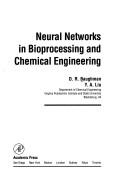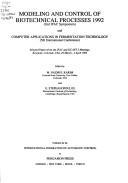| Listing 1 - 10 of 30 | << page >> |
Sort by
|
Book
Year: 2018 Publisher: Basel : MDPI - Multidisciplinary Digital Publishing Institute,
Abstract | Keywords | Export | Availability | Bookmark
 Loading...
Loading...Choose an application
- Reference Manager
- EndNote
- RefWorks (Direct export to RefWorks)
The goal of bioprocessing is to optimize process variables, such as product quantity and quality, in a reproducible, scalable, and transferable manner. However, bioprocesses are highly complex. A large number of process parameters and raw material attributes exist, which are highly interactive, and may vary from batch to batch. Those interactions need to be understood, and the source of variance must be identified and controlled. While purely data-driven correlations, such as chemometric models of spectroscopic data, may be employed for the understanding how process parameters are related to process variables, they can hardly be deployed outside of the calibration space. Currently, mechanistic models, models based on mechanistic links and first principles, are in the focus of development. They are perceived to allow transferability and scalability, because mechanistics can be extrapolated. Moreover, the models deliver a large range of hardly-measureable states and physiological parameters. The current Special Issue wants to display current solutions and case studies of development and deployment of hybrid models and multi-parametric control of bioprocesses. It includes: -Models for Bioprocess Monitoring -Model for Bioreactor Design and Scale Up -Hybrid model solutions, combinations of data driven and mechanistic models. -Model to unravel mechanistic physiological regulations -Implementation of hybrid models in the real-time context -Data science driven model for process validation and product life cycle management.
Book
Year: 2018 Publisher: Basel : MDPI - Multidisciplinary Digital Publishing Institute,
Abstract | Keywords | Export | Availability | Bookmark
 Loading...
Loading...Choose an application
- Reference Manager
- EndNote
- RefWorks (Direct export to RefWorks)
The goal of bioprocessing is to optimize process variables, such as product quantity and quality, in a reproducible, scalable, and transferable manner. However, bioprocesses are highly complex. A large number of process parameters and raw material attributes exist, which are highly interactive, and may vary from batch to batch. Those interactions need to be understood, and the source of variance must be identified and controlled. While purely data-driven correlations, such as chemometric models of spectroscopic data, may be employed for the understanding how process parameters are related to process variables, they can hardly be deployed outside of the calibration space. Currently, mechanistic models, models based on mechanistic links and first principles, are in the focus of development. They are perceived to allow transferability and scalability, because mechanistics can be extrapolated. Moreover, the models deliver a large range of hardly-measureable states and physiological parameters. The current Special Issue wants to display current solutions and case studies of development and deployment of hybrid models and multi-parametric control of bioprocesses. It includes: -Models for Bioprocess Monitoring -Model for Bioreactor Design and Scale Up -Hybrid model solutions, combinations of data driven and mechanistic models. -Model to unravel mechanistic physiological regulations -Implementation of hybrid models in the real-time context -Data science driven model for process validation and product life cycle management.
Book
ISBN: 0841215499 Year: 1995 Publisher: Washington, District of Columbia : American Chemical Society,
Abstract | Keywords | Export | Availability | Bookmark
 Loading...
Loading...Choose an application
- Reference Manager
- EndNote
- RefWorks (Direct export to RefWorks)
Biosensors --- Chemical detectors --- Biotechnological process monitoring --- Biotechnological process control
Book
Year: 1995 Publisher: [Washington, D.C.] : [U.S. Government Printing Office],
Abstract | Keywords | Export | Availability | Bookmark
 Loading...
Loading...Choose an application
- Reference Manager
- EndNote
- RefWorks (Direct export to RefWorks)
Patent laws and legislation --- Biotechnological process control --- United States.
Book
Year: 1998 Publisher: Dordrecht Boston Kluwer Academic Publishers
Abstract | Keywords | Export | Availability | Bookmark
 Loading...
Loading...Choose an application
- Reference Manager
- EndNote
- RefWorks (Direct export to RefWorks)
Book
Year: 1995 Publisher: [Washington, D.C.] : [U.S. Government Printing Office],
Abstract | Keywords | Export | Availability | Bookmark
 Loading...
Loading...Choose an application
- Reference Manager
- EndNote
- RefWorks (Direct export to RefWorks)
Patent laws and legislation --- Biotechnological process control --- United States.

ISBN: 0120830302 Year: 1995 Publisher: San Diego : Academic Press,
Abstract | Keywords | Export | Availability | Bookmark
 Loading...
Loading...Choose an application
- Reference Manager
- EndNote
- RefWorks (Direct export to RefWorks)
Biotechnological process control. --- Chemical process control. --- Neural computers.
Book
ISBN: 3030716554 9783030716554 3030716562 Year: 2021 Volume: 177 Publisher: Springer International Publishing
Abstract | Keywords | Export | Availability | Bookmark
 Loading...
Loading...Choose an application
- Reference Manager
- EndNote
- RefWorks (Direct export to RefWorks)
Book
ISBN: 3038427462 Year: 2018 Publisher: Basel, Switzerland : MDPI,
Abstract | Keywords | Export | Availability | Bookmark
 Loading...
Loading...Choose an application
- Reference Manager
- EndNote
- RefWorks (Direct export to RefWorks)
The goal of bioprocessing is to optimize process variables, such as product quantity and quality, in a reproducible, scalable, and transferable manner. However, bioprocesses are highly complex. A large number of process parameters and raw material attributes exist, which are highly interactive, and may vary from batch to batch. Those interactions need to be understood, and the source of variance must be identified and controlled. While purely data-driven correlations, such as chemometric models of spectroscopic data, may be employed for the understanding how process parameters are related to process variables, they can hardly be deployed outside of the calibration space. Currently, mechanistic models, models based on mechanistic links and first principles, are in the focus of development. They are perceived to allow transferability and scalability, because mechanistics can be extrapolated. Moreover, the models deliver a large range of hardly-measureable states and physiological parameters. The current Special Issue wants to display current solutions and case studies of development and deployment of hybrid models and multi-parametric control of bioprocesses. It includes: -Models for Bioprocess Monitoring -Model for Bioreactor Design and Scale Up -Hybrid model solutions, combinations of data driven and mechanistic models. -Model to unravel mechanistic physiological regulations -Implementation of hybrid models in the real-time context -Data science driven model for process validation and product life cycle management.
Biotechnological process control. --- Bioprocess control --- Biotechnical process control --- Biotechnology --- Process control

ISBN: 0080417108 Year: 1992 Publisher: Oxford : Pergamon press,
Abstract | Keywords | Export | Availability | Bookmark
 Loading...
Loading...Choose an application
- Reference Manager
- EndNote
- RefWorks (Direct export to RefWorks)
Biotechnological process control --- Biotechnology --- Fermentation --- Congresses. --- Mathematical models --- Congresses. --- Data processing --- Congresses.
| Listing 1 - 10 of 30 | << page >> |
Sort by
|

 Search
Search Feedback
Feedback About UniCat
About UniCat  Help
Help News
News